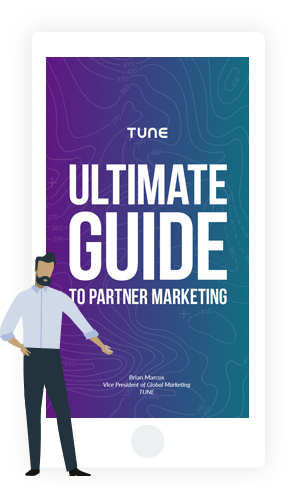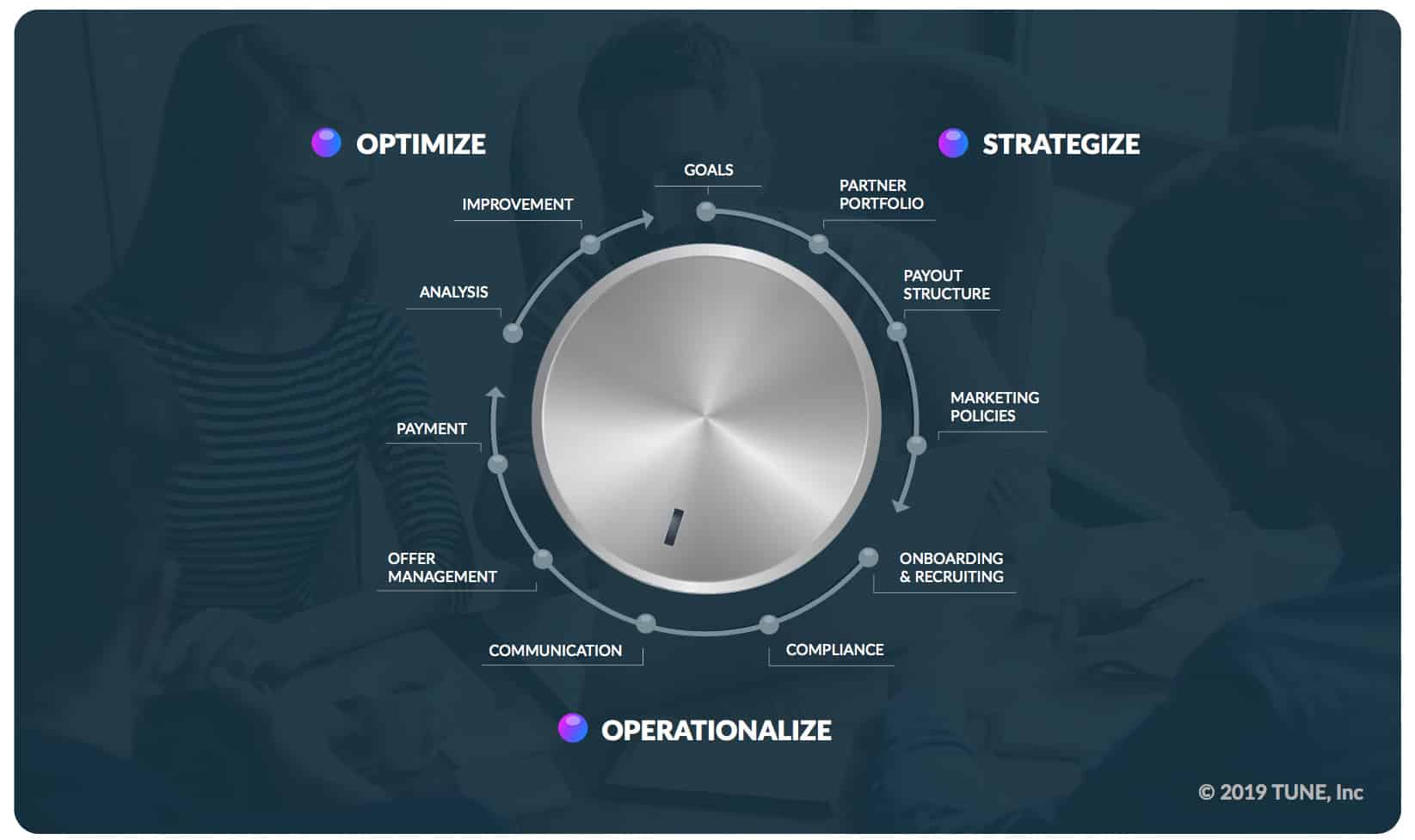Welcome to Part 4 of our Ultimate Guide to Partner Marketing series! In this blog series, we are breaking down strategies from our new e-book, The Ultimate Guide to Partner Marketing with examples from real partner programs. In case you missed the first half of the series, check out Part 1, Part 2, and Part 3.
In Part 3, we talked about different ways and strategies for recruiting affiliates to your program. In today’s blog post, we will review how to enforce the rules of your partner program through effective communication. We will also take a look at some of the consequences of poor policy enforcement in early affiliate programs and explore tips for how advertisers can improve compliance within their own branded programs.
Putting Policy Into Action
So far, we’ve covered the Strategize section of the TUNE In Framework, and began exploring the Operationalize section in the last post. Today, we’re moving on to compliance and communication.
By now, you have the keys to planning a successful partner program strategy, and you know how to recruit affiliates. Now that you have launched your program and have engaged partners, you need to communicate with them.
Communicating for Partner Compliance
Simply setting policy isn’t enough. For an affiliate marketing program to succeed, a brand must enforce the policies it has set. (The easiest way to manage all of this? With a partner marketing platform such as TUNE.)
Once your program is live, the first step to partner compliance is driving home the rules at every turn:
- Reiterate rules via auto-response messages.
- Include policy updates in partner email newsletters.
- Host copies of signed contracts and agreements in partner accounts.
- Provide terms of service and policy information on your website’s partner program page.
- Strive to have a policy that is informative, understandable, and balances what partners are allowed and not allowed to do.
In addition, you’ll want to check up on partners to make sure they are following the rules. This boils down to understanding where a partner is advertising and to whom they are advertising. One way to do this is to ask new partners to provide a screenshot of your offer’s placement. Another way is to analyze partner results each day, paying extra attention to a partner’s average order value (AOV) and customer lifetime value (LTV). If one day is gangbusters but the next is silent, or a partner’s sales start slow and then skyrocket inexplicably, there may be something odd going on.
When it comes to communicating all of this with your partners, follow the golden rule of marketing: right message, right user, right time. Consider using different methods for different stages of your program, such as a welcome email to all new partners, and in-platform earning notifications or personal notes for your top affiliates. For the best results, segment your partners by type or audience to make it easier to tailor messaging that will resonate with each group.
Lastly, remember the other golden rule: treat others as you want to be treated. You want to feel special, valued, and that your needs and interests are being heard, right?
Your partners — especially top partners and super affiliates — are just the same. It’s important to be as transparent and informative as possible before any sticky situations occur; once they do, constructive feedback (and a little tact) can turn a possibly ruined relationship into a motivating one. Keep these two tips in mind:
- Describe clearly and upfront what remediation looks like for any policy violations. Commonly, it means that partners have to demonstrate change. This can be a change in the way they use their software or a change in the way they promote your brand.
- Communicate early and often with any partners that display non-compliant behavior. When this happens, provide them with specific, workable recommendations that are within the boundaries of your policy.
For more details on communication methods and strategies, plus tips for enforcing compliance, check out the full free version of The Ultimate Guide to Partner Marketing.
Enforcing Compliance: Real World, Real Consequences
Perhaps the most famous example of the consequences of poor policy enforcement is the case of Shawn Hogan and Brian Dunning, who used cookie stuffing to defraud eBay out of at least $20 million between 2006 and 2007. (In total, eBay paid them more than $35 million from 2000-2007.)
The case is a classic he-said she-said mess, with Hogan and Dunning claiming that eBay’s terms of service allowed them to take advantage of the program and that contacts at eBay encouraged non-compliant behavior, while eBay and Commission Junction, which ran the affiliate program for eBay at the time, alleged that Hogan and Dunning lied about their methods and intentionally deceived contacts at both companies. Eventually, both affiliates were sentenced to less than a year and a half of jail time and fines of $25,000 each — chump change compared to the millions eBay had paid them over the years.
Ultimately, this situation led eBay to migrate its business off of Commission Junction and run its own in-house network. It was eBay’s attempt to more directly control the policies and enforcement efforts that had allowed Hogan and Dunning’s non-compliant behavior in the first place.
The case is a stark warning to any brand with an affiliate program. Without the correct policies in place, and the manpower and technology to enforce them, you risk losing more than money — you could lose business, relationships, and your reputation.
In general, brands can up their enforcement game by educating partner program managers about common types of advertising fraud and who in the industry they benefit. Avoid working with known bad actors by checking resources that list them and their violations, such as Ben Edelman’s website. Finally, search out trusted partners like BrandVerity that provide tools and services that help to verify offer placements and affiliate promotions.
Coming Up
With communication and compliance for partner programs behind us, we’re more than halfway through the TUNE In Framework. That means the next installment in the series will focus on best practices for managing offers and campaigns. Check back in two weeks for Part 5!
The TUNE Partner Marketing Platform is the industry’s most flexible SaaS solution for managing marketing partnerships across mobile and web. Request a trial today or send us your questions at [email protected].

Learn how to plan, build, and grow cross-channel partner programs with our Ultimate Guide to Partner Marketing series. Follow along as we introduce strategies from the Ultimate Guide and bring them to life with real use cases from leading brands and advertisers.
- Part 1 – Planning Your Partner Program Strategy
- Part 2 – Determining Partner Payouts and Marketing Policies
- Part 3 – Recruiting and Onboarding Partners
- Part 4 – Communicating for Partner Compliance
- Part 5 – Managing Partner Offers
- Part 6 – Partner Payments
- Part 7 – Program Analysis and Optimization
Author
Becky is the Senior Content Marketing Manager at TUNE. Before TUNE, she handled content strategy and marketing communications at several tech startups in the Bay Area. Becky received her bachelor's degree in English from Wake Forest University. After a decade in San Francisco and Seattle, she has returned home to Charleston, SC, where you can find her strolling through Hampton Park with her pup and enjoying the simple things in life.





Leave a Reply
You must be logged in to post a comment.